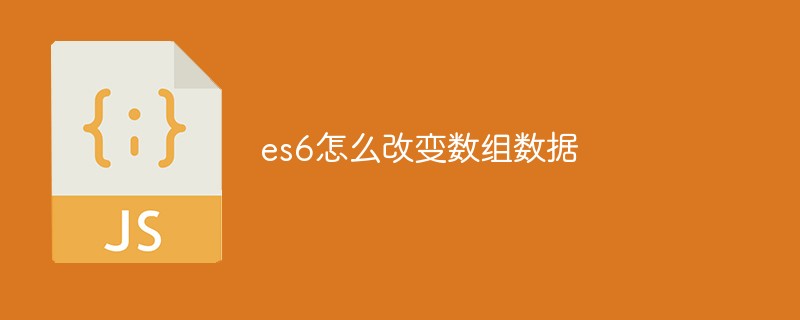 Web Front-end
Web Front-end JS Tutorial
JS Tutorial Introduction to the usage of destructuring assignment of variables in ES6 (with code)
Introduction to the usage of destructuring assignment of variables in ES6 (with code)This article brings you an introduction to the usage of destructuring and assigning variables in ES6 (with code). It has certain reference value. Friends in need can refer to it. I hope it will be helpful to you.
Destructuring assignment of arrays
Basic usage
ES6 allows extracting values from arrays and objects and assigning values to variables according to a certain pattern, which is called a structure.
Before ES6, if you wanted to assign a value to a variable, you could only specify its value, as follows:
let a = 1; let b = 2
In ES6, you can write it like this, as follows:
let [a,b] = [1,2] // a = 1, b = 2
It’s worth noting Yes, the values on both sides of the equation must be equal, so that the variable on the left will be assigned the corresponding value on the right. If the value on the left is not equal, undefined will appear, as follows:
let [foo,[[bar],baz]] = [1,[[2],3]] foo // 1 bar // 2 baz // 3 注意:只有左右两边的 格式一定要对等,数量可以不对等。 let [a,b,c] = [1,2] a = 1, b = 2, c = undefined let [a,,c] = [1,2,3] a = 1, c = 3 let [a, ...b] = [1,2,3] a = 1, b = [2,3] let [a] = [] let [b,a] = [1] a = undefined
There is another situation where the left side of the equal sign is an array, but the right side of the equal sign is other values, and an error will be reported. As follows:
let [a] = 1;
let [a] = false;
let [a] = NaN;
let [a] = undefined;
let [a] = null;
let [a] = {};
以上都会报错
But if the left is an array and the right is a string, the value of the first subscript of the string will be taken
let [a] = '121321' a = '1' let [a] = 'adgasg' a = 'a'
For the Set structure, you can also use the destructuring assignment of the array .
let [x,y,z] = new Set([1,2,3]) x = 1, y = 2, z = 3
Default value
Destructuring assignment allows specifying a default value
let [a = 3] = [] // a:3 let [a = 3,b] = [,4] // a:3 b:4 let [a = 3,b] = [5,4] // a:5 b:4
Special
let [a = 3] = [undefined] // a:3 let [a = 3] = [null] // a:null
Tips: Use the strict equality operator in es6 to assign values to the structure If the default value needs to be effective, the default value should be used only when the equivalent value is undefined, otherwise assignment will still be used. null in the above is not strictly equal to undefined
If the assignment of the default value is an expression, only when the assignment on the right side of the equal sign does not have a value of undefined, the value in the expression will be taken Value, as follows:
function demo(){
console.log('demo')
}
let [a = demo()] = [] // a: demo
let [a = demo()] = [1] // a : 1
Destructuring assignment of objects
The difference from arrays is that the elements of the array must be in the same position as the assigned elements for correct assignment, while the destructuring assignment of objects is The correct value can be obtained if the variables and attributes on both sides of the equal sign have the same name. Otherwise the value is undefined
let {a,b} = {a:'23',b:'3'}
let {a,b} = {b:'3',a:'23'}
// 上面两个的值 都是 a: 23 b: 3
let {a,b} = {a:'3',c:'d'}
//a: 3 b: undefined
Destructuring assignment of the object and assigning the method of an existing object to a new variable, as follows:
let {sin,cos} = Math
// Math 中的sin cos 方法将赋值给变量 sin cos
let {log} = console
// log(2) === console.log(2)
If the equal sign The variable name on the left cannot be consistent with the attribute name of the object on the right side of the equal sign, and must be written in the following format:
let {a:b} = {a:'ss'} // b:ss
//a是属性名,b才是实际赋值的变量名
The destructuring assignment of the object can also be nested destructuring, as follows:
第一种:
let obj = {
p:[
'Hello',
{y:'world'}
]
}
let {p:[x,{y}]} = obj
// x: Hello, y: world
这边的p只是属性不是变量,如果p想赋值可以写成:
let {p,:[x,{y}]} = obj
第二种:
const a = {
loc: {
t :1,
b :{
c:1,
d:2
}
}
}
let {loc:{t,b:{c,d}}} = a
或者
let {loc,loc:{t,b,b:{c,d}}} = a
Nested assignment
let o = {}, arr = []
({foo:o.prop,bar: arr[0]} = {foo:123,bar:true})
//o: 123, arr = [true]
If the destructuring mode is a nested object, if the parent property of the child object does not exist, an error will be reported, as follows:
let {foo:{bar}} = {baz:'baz'} //报错
Default value
let {x = 3} = {}
// x: 3
let {x,y = 5} = {x : 1}
// x: 1, y: 5
let {x: y = 5} = {}
// y = 5
let {x: y = 5} = {x : 4}
// y = 4
let {x: y = 'hhhh'} = {}
//y = 'hhhh'
Tips:以上左边 x为属性名,y为变量
let {x = 5} = {x: undefined}
// x: 5
let {x = 4} = {x: null}
// x: null
同数组一样遵循 严格等于
只有右边为undefined的时候默认值才会生效
Note:
1) Declared variables cannot be used for destructuring assignment because they are already a code block.
Destructuring assignment of string
If the assignment object is an array, the string will be split into the format of the array, corresponding to the assignment
let [a,b] = 'ha'
// a = h , b = a
同时可以获得字符串的长度:
let {length:len} = '12121'
// len = 5
Numbers and Boolean values Destructuring assignment
If the right side of the equal sign is a number or Boolean value, it will be converted into an object. In other words, except for arrays and objects, other values will be converted into objects, except null and undefined. As follows:
let {t:s} = 123
let {t: s} = true
Destructuring assignment of function parameters
function add([x,y]){
return x+y
}
add([3,5]) // 8
[[3,5],[6,7]].map(([a,b]) => a + b)
//8 , 13
function m({x=3, y=4} = {}){
return [x,y]
}
m({x:33,y:8}) // [33,8]
m({x:32}) // [32,4]
m({}) // [3,4]
m() // [3,4]
function m({x,y} = {x=0,y=0}){
return [x,y]
}
m({x:33,y:8}) // [33,8]
// 代替右边的 x:0, y:0 所以是传值 33 8
m({x:32}) // [32,undefined]
//因为传值替代右边的赋值,但是只有x没有y
//所以y是取 左边y的默认值,因为你没有赋值 为undefined
m({}) // [undefined,undefined]
// 取左边x,y的默认值,因为没有赋值 为undefined
m() // [0,0]
// 没有传值,使用本身的赋值 都是0
Others
When parentheses cannot be used
- Variable declaration statement
- Function parameters
- Mode of assignment statement
When parentheses can be used
- In the non-mode part of assignment statement, parentheses can be used
The purpose of destructuring assignment
- Exchanging the value of a variable
- Returning multiple values from a function
- Definition of function parameters
- Extract JOSN data
- Default values of function parameters
- Traverse the Map structure
- Specification method of input module
The above is the detailed content of Introduction to the usage of destructuring assignment of variables in ES6 (with code). For more information, please follow other related articles on the PHP Chinese website!
 es6怎么判断是否为数组Apr 25, 2022 pm 06:43 PM
es6怎么判断是否为数组Apr 25, 2022 pm 06:43 PM在es6中,可以利用“Array.isArray()”方法判断对象是否为数组,若判断的对象是数组,返回的结果是true,若判断对象不是数组,返回的结果是false,语法为“Array.isArray(需要检测的js对象)”。
 es6中遍历跟迭代的区别是什么Apr 26, 2022 pm 02:57 PM
es6中遍历跟迭代的区别是什么Apr 26, 2022 pm 02:57 PMes6中遍历跟迭代的区别是:遍历强调的是要把整个数据依次全部取出来,是访问数据结构的所有元素;而迭代虽然也是依次取出数据,但是并不保证取多少,也不保证把所有的数据取完,是遍历的一种形式。
 es6中怎么判断两个对象是否相等Apr 19, 2022 pm 03:34 PM
es6中怎么判断两个对象是否相等Apr 19, 2022 pm 03:34 PM在es6中,可用Object对象的is()方法来判断两个对象是否相等,该方法检测两个变量的值是否为同一个值,判断两个对象的引用地址是否一致,语法“Object.is(对象1,对象2)”;该方法会返回布尔值,若返回true则表示两个对象相等。
 es6怎么将数字转为字符串Apr 19, 2022 pm 06:38 PM
es6怎么将数字转为字符串Apr 19, 2022 pm 06:38 PM转换方法:1、利用“+”给数字拼接一个空字符,语法“数字+""”;2、使用String(),可把对象的值转换为字符串,语法“String(数字对象)”;3、用toString(),可返回数字的字符串表示,语法“数字.toString()”。
 es6中assign的用法是什么May 05, 2022 pm 02:25 PM
es6中assign的用法是什么May 05, 2022 pm 02:25 PM在es6中,assign用于对象的合并,可以将源对象的所有可枚举属性复制到目标对象;若目标对象与源对象有同名属性,或多个源对象有同名属性,则后面的属性会覆盖前面的属性,语法为“Object.assign(...)”
 sort排序是es6中的吗Apr 25, 2022 pm 03:30 PM
sort排序是es6中的吗Apr 25, 2022 pm 03:30 PMsort排序是es6中的;sort排序是es6中用于对数组的元素进行排序的方法,该方法默认不传参,按照字符编码顺序进行排序,排序顺序可以是字母或数字,并按升序或降序,语法为“array.sort(callback(a,b))”。
 es6怎么改变数组数据Apr 26, 2022 am 10:08 AM
es6怎么改变数组数据Apr 26, 2022 am 10:08 AM改变方法:1、利用splice()方法修改,该方法可以直接修改原数组的内容,语法为“数组.splice(开始位置,修改个数,修改后的值)”;2、利用下标访问数组元素,并重新赋值来修改数组数据,语法为“数组[下标值]=修改后的值;”。
 import as在es6中的用法是什么Apr 25, 2022 pm 05:19 PM
import as在es6中的用法是什么Apr 25, 2022 pm 05:19 PM在es6中,import as用于将若干export导出的内容组合成一个对象返回;ES6的模块化分为导出与导入两个模块,该方法能够将所有的导出内容包裹到指定对象中,语法为“import * as 对象 from ...”。


Hot AI Tools

Undresser.AI Undress
AI-powered app for creating realistic nude photos

AI Clothes Remover
Online AI tool for removing clothes from photos.

Undress AI Tool
Undress images for free

Clothoff.io
AI clothes remover

AI Hentai Generator
Generate AI Hentai for free.

Hot Article

Hot Tools

PhpStorm Mac version
The latest (2018.2.1) professional PHP integrated development tool

MantisBT
Mantis is an easy-to-deploy web-based defect tracking tool designed to aid in product defect tracking. It requires PHP, MySQL and a web server. Check out our demo and hosting services.

SublimeText3 Linux new version
SublimeText3 Linux latest version

SecLists
SecLists is the ultimate security tester's companion. It is a collection of various types of lists that are frequently used during security assessments, all in one place. SecLists helps make security testing more efficient and productive by conveniently providing all the lists a security tester might need. List types include usernames, passwords, URLs, fuzzing payloads, sensitive data patterns, web shells, and more. The tester can simply pull this repository onto a new test machine and he will have access to every type of list he needs.

EditPlus Chinese cracked version
Small size, syntax highlighting, does not support code prompt function






